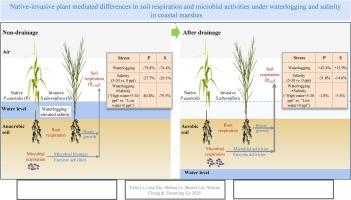芦苇和互花米草沼泽土壤呼吸和微生物活性对水文变化的响应
IF 6.6
1区 农林科学
Q1 SOIL SCIENCE
引用次数: 0
摘要
沿海湿地面临海平面上升带来的前所未有的挑战;然而,涝渍和盐度增加对土壤呼吸的影响尚不清楚,特别是考虑到优势沼泽物种(如原生芦苇和入侵互花米草)的不同抗逆性策略。我们进行了一个中观实验,比较了这两个物种对涝渍(控制:低水位,处理:高水位)和盐度(控制:0 ppt,处理:5、15和30 ppt)的土壤呼吸反应,同时也研究了潜在的机制和排水的作用。在淹水条件下,高水位显著抑制了土壤呼吸,南草比互花草减少的幅度更大(78.9%比74.4%)。高盐度(30 ppt)对南洋蓟(P. australis)比互花蓟(S. alterniflora)的降低幅度更大(56.4%比28.9%)。排水条件从根本上改变了这些反应;在高水位下,南菖蒲表现出更大的排水后增强(42.4%比12.9%),但对盐度始终表现出更高的敏感性。这些物种特异性反应是由根系生物量、微生物生物量碳和碳循环酶活性的差异变化介导的。主成分分析结果表明,在不同的胁迫条件下,互花草保持较高的生物活性,南芥表现出较强的胁迫敏感性。涝渍和盐度对土壤呼吸具有非加性影响,互花草通过持续的微生物活性和根系功能表现出较强的耐受性。我们的研究结果强调了在预测未来海平面上升情景下沿海湿地碳循环时考虑物种特异性适应策略和潮汐动态的重要性,因为这些生态上重要的物种的不同应激反应可能会极大地影响生态系统的碳动态。本文章由计算机程序翻译,如有差异,请以英文原文为准。

Responses of soil respiration and microbial activity in Phragmites australis and Spartina alterniflora marshes to hydrological changes
Coastal wetlands face unprecedented challenges from sea-level rise; however, the effects of increased waterlogging and salinity on soil respiration remain unclear, particularly given the contrasting stress tolerance strategies of dominant marsh species such as native Phragmites australis and invasive Spartina alterniflora. We conducted a mesocosm experiment to compare soil respiration responses to waterlogging (control: low water level; treatment: high water level) and salinity (control: 0 ppt; treatments: 5, 15, and 30 ppt) between these two species, while also examining the underlying mechanisms and the role of drainage. Under waterlogged conditions, high water levels significantly suppressed soil respiration, with P. australis exhibiting a greater reduction than S. alterniflora (78.9 % vs. 74.4 %). The species showed distinct responses to salinity: high salinity (30 ppt) caused a more pronounced reduction in P. australis than in S. alterniflora (56.4 % vs. 28.9 %). Drainage conditions fundamentally altered these responses; P. australis showed a greater post-drainage enhancement under high water level (42.4 % vs. 12.9 %) but consistently exhibited higher sensitivity to salinity. These species-specific responses were mediated by differential changes in root biomass, microbial biomass carbon, and carbon-cycling enzyme activities. Principal component analysis revealed clear ecological niche separation along the stress gradients, with S. alterniflora maintaining higher biological activity and P. australis displaying greater stress sensitivity under severe combined conditions. The combined effects of waterlogging and salinity revealed non-additive impacts on soil respiration, with S. alterniflora demonstrating superior tolerance through sustained microbial activity and root functioning. Our findings underscore the importance of considering species-specific adaptive strategies and tidal dynamics when predicting coastal wetland carbon cycling under future sea-level rise scenarios, as the differential stress responses of these ecologically significant species may substantially influence ecosystem carbon dynamics.
求助全文
通过发布文献求助,成功后即可免费获取论文全文。
去求助
来源期刊

Geoderma
农林科学-土壤科学
CiteScore
11.80
自引率
6.60%
发文量
597
审稿时长
58 days
期刊介绍:
Geoderma - the global journal of soil science - welcomes authors, readers and soil research from all parts of the world, encourages worldwide soil studies, and embraces all aspects of soil science and its associated pedagogy. The journal particularly welcomes interdisciplinary work focusing on dynamic soil processes and functions across space and time.
 求助内容:
求助内容: 应助结果提醒方式:
应助结果提醒方式:


